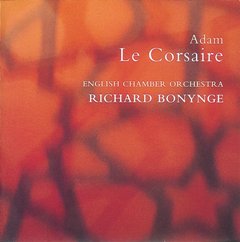Adolphe Adam - Le Corsaire (2010)
Adolphe Adam - Le Corsaire (2010)

CD1 Act I 01. Overture 00. Scene 1 Opening 00. Pas de cinq: 02. _ Introduction 03. _ Tarantella 04. _ Mazuetta 05. _ La Francaise 06. _ Bolero 07. _ Danse anglaise (Ecossaise) 08. _ Coda 09. Action 10. bacchanale des corsaires 00. Scene 2 11. Action 12. Pas des eventails 13. Action 14. Variation (for Mlle Grantzow, 1867) 15. Action CD2 Act II 01. Pas des odalisques 02. Entree de Gulnare 03. Danse de Gulnare 04. Action Act III 00. Scene 1 05. Action 00. Pas des fleurs (Delibes, 1867): 06. _ Valse de Naila (for Mlle Grantzow) 07. _ Andante 08. _ 1st variation (for Gulnare, Mlle Fioretti) 09. _ 2ns variation (for Medora, Mlle Grantzow) 10. _ Finale 11. Action 12. Scene 2 00. Scene 3 13. Storm and shipwreck English Chamber Orchestra Richard Bonynge - conductor
"Le Corsaire" was first presented in 1856 at the Theatre de l'Academie Imperiale de Musique in Paris. The ballet's choreography was the work of the great Balletmaster Joseph Mazilier, with music by Adolphe Adam..
In 1867 - especially for the Prima Ballerina Adele Grantzow, and in celebration of the Universal Exposition given in Paris - Mazilier came out of retirement to revive "Le Corsaire". For this revival the Balletmaster re-arranged much of the ballet, and added the famous 'Pas des fleurs' (known today as 'Le jardin anime') to the music of Leo Delibes. After Grantzow left Paris, the work was never again performed by the Parisian ballet.
The versions of "Le Corsaire" familiar to audiences today - primarily those of American Ballet Theatre and the Kirov/Mariinsky Ballet - have their roots in the many revivals of produced by Marius Petipa for the Imperial Ballet of St. Petersburg. By way of Petipa's revivals, Adam's score for "Le Corsaire" acquired a substantial number of additional music for various pas, variations, scenes, and incidental dances (by the time Petipa staged his final revival in 1899, the score included pieces from 10 composers aside from Adam).
Musically, the history of "Le Corsaire" can get rather confusing, and it doesn't help that the world's two principal productions of this ballet - American Ballet Theatre and the Kirov/Mariinsky Ballet respectively - present 2 almost totally different scores. The Kirov/Mariinsky Ballet's version Is erived from the balletmaster Pyotr Gusev and the ballet historian Yuri Slonimsky's 1955 production for the Maly Theatre in Leningrad, includes a score fashioned from the airs of Adolphe Adam's opera "Si J'etais Roi" and his ballet "La Jolie Fille du Gand", with the usual inclusion of Petipa's additional dances. American Ballet Theatre's version - being derived from the former Kirov artistic director Konstantin Sergeyev's 1973 version - is far more faithful to Petipa's productions, but is still somewhat of an abomination with regards to its obsurd characterizations and Corsaires transformed into ridiculous pirates à la Blackbeard or Captain Hook.
The manuscript utilized in this recording by Richard Bonynge was the original conductor's score used in Paris in 1867 for Mazilier's revival, and was obtained from the archives of the Paris Opera. Unfortunatly it does not include the later additions as added by Petipa (or his successors), but it does include the scene 'Le Jardin Anime' as originally composed by Leo Delibes. Most people are familiar with the Mariinsky version of the music for this scene, which is still presented in St. Petersburg and by most other companies in an orchestration by Cesare Pugni.
The music as presented in this recording is wonderful. Included is the Act I 'Pas de Cinq' of the National Dances (completely lost from every modern production to date); the elaborate 'Pas de Eventails' (another number that is lost) in which the lead character of Medora and a group of 16 ballerinas perform with fans to create a 'Peacock' effect; Adam's magnificent music for the 'Pas de Odalisques'; as is the 1867 additions of Delibes for the scene 'Le Jardin Anime'. Bonynge does a first rate job conducting the music.
In 2006 the Bavarian State Ballet presented a fantastic revival of "Le Corsaire" for which they made use of Adam's original score. The company also reconstructed 25 of Petipa's original dances from "Le Corsaire" as documented in the Stepanov method of choreographic notation from the Sergeyev Collection. In 2007 the Bolshoi Ballet staged an even more lavish revival of "Le Corsaire" for which they used nearly all of Adam's original score, restoring the mise-en-scene to its original form and also using the Sergeyev Collection to include Petipa's dances. Adam's original music for the 'Pas des Eventails' was deleted, and in its place the 'Grand pas' from Riccardo Drigo's score for Lev Ivanov's 1887 ballet "The Enchanted Forest" was used (I must say that Drigo's music is absolutely divine in every respect). Let us hope the production is filmed and released to DVD in the future, so that everyone can view what this ballet should be. --- MrLopez2681 "Obsessive archaeologist of the B... (USA)
download: uploaded anonfiles mega 4shared mixturecloud yandex
Zmieniony (Niedziela, 04 Sierpień 2013 13:33)








